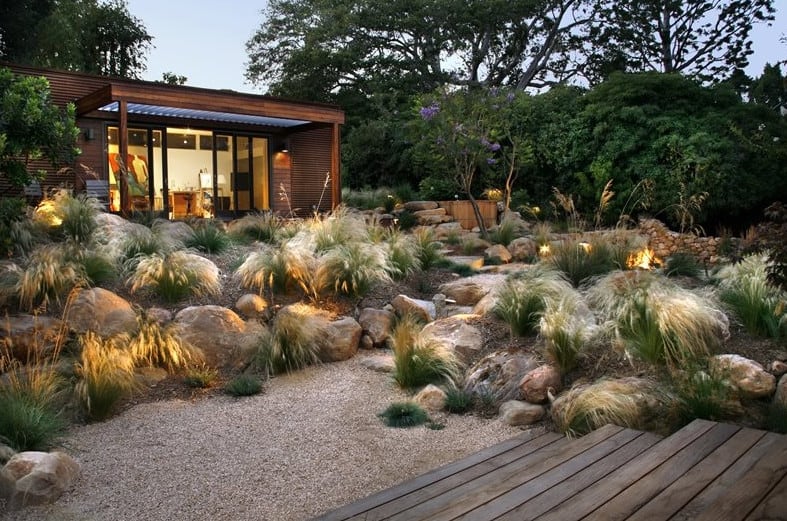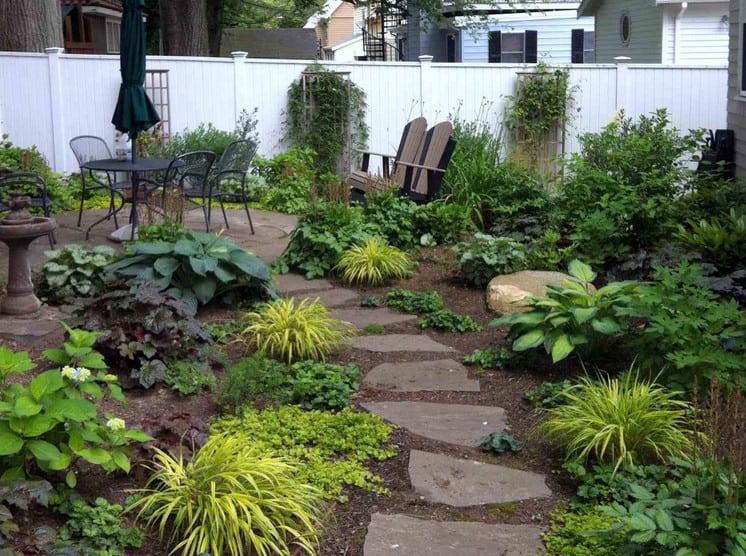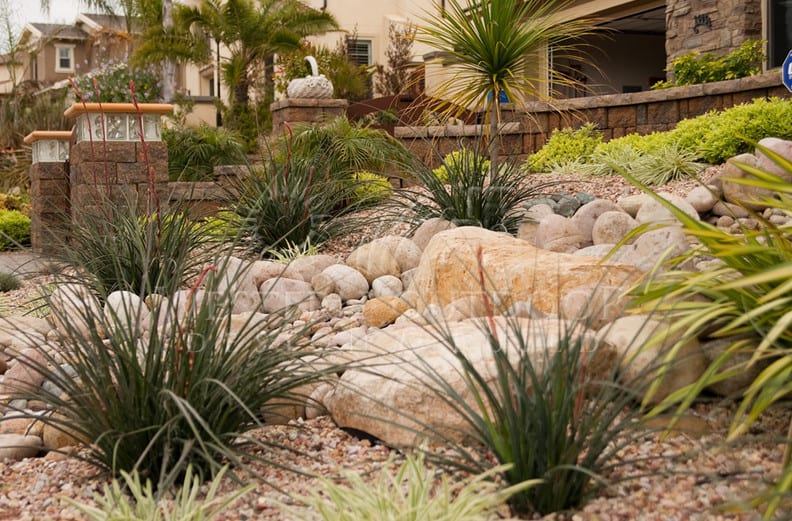Xeriscaping is a term that refers to any landscaping technique that aims at conserving water through creative landscaping. This term is a Greek word derived from the term xeros, meaning dry.
The term scape refers to a scene or a view. But what’s the main purpose of xeriscaping? This technique focuses on landscaping by planting drought tolerant and slow-growing varieties of plants, according to our Sydney landscape NSW experts. This way, it becomes easier to save water by having a water-efficient landscape.

Image Source: landscapingnetwork.com
Briefly, this technique involves selecting ideal plants and an efficient irrigation system. Although a balance between resource requirements and aesthetics is not easy to achieve in this technique, the results are quite satisfying.
Advantages of Xeriscaping
Now that you know what this technique is all about, you might now wonder why someone would want to use it in gardening. Here are the advantages of using this technique:
-
Conserving Water
A lot of water is usually used up for gardening. If you integrate this technique in gardening, then you can reduce water usage by up to 50-75 percent.
This means that you will save a lot on bills and even impact the environment positively. Moreover, some areas are affected by excessive drought such that they must adapt to water conserving techniques when gardening.
-
Requires Little Maintenance
Generally, xeriscaping requires minimal maintenance. You will still do some weeding and pruning from time to time, but you will not really be stressed about it.
You can integrate a simple and efficient irrigation system to water your plants, such that you will not have to keep on watering your plants. In fact, most people opt for this technique for it makes gardening easier.
-
It Is All Natural
A priceless advantage that basically comes with choosing native plants is that you will not have to use any chemical supplements.
All you should do is use quality organic soil that has all the necessary nutrients for the plants to flourish. This will save you money, effort, and time. Moreover, you will have healthy organic plants especially fruits and vegetables.
-
There Is No Pollution
Another key benefit of this technique is that it cares for the nature. It assists in reducing environmental pollution. Other gardening techniques such as gas mowers use fossil fuel and this leads to pollution.
Xeriscaping cuts down on such pollution issues. You can simply use reel mowers when maintaining a small turf area and this will cut down on pollution.
-
Creating a Wildlife Habitat
Xeriscaping relies on growing native plants alongside trees, and shrubs. This creates a great wildlife habitat.
Native plants grow nicely within their natural habitat. This way, you support the nature and environment around you.

Image Source: fleagor.com
The Basics of Xeriscaping- What You Should Know
-
Water Consumption
Like previously noted, the key purpose of this gardening technique is water consumption. Some positive gains have been made on reducing water consumption, but most landscape designers are still struggling to reduce water consumption.
In xeriscaping, you need to get informed on gardening principles that reduce water usage. Before you make a plan for your garden, start with visiting local nurseries and check locally available plants and trees that are drought resistant and see the ones you may use in your garden. Also consider annual rainfall levels in your location.
You should also analyze your landscape. Check which areas are shady and sunny, and also assess areas that require more water than others. A good idea would be grouping plants with respect to their water needs.
Next, check the shape of your land and its drainage patterns. Here, you can develop some terraces. Make sure you position trees and shrubs in a manner that will offer natural cooling for the nearby buildings.
-
Soil Improvement
A landscape that conserves water relies on special soils. Such soils must store water and drain quickly.
You can improve your soil by adding organic material and keeping it aerated. You can use compost matter as organic additives. However, in case you have succulents and cacti in plenty, then use a lean soil.
In the event that you are not sure about your soil condition, have it tested by a specialist or purchase a test kit. If the soil is alkaline and lacks sufficient phosphorous, then you can add bone meal and rock phosphate to make it ideal for planting.
-
Limiting the Turf Areas
It is advisable to minimize the turf areas in your garden. You would still require some grass for aesthetic reasons, but if you would want to add more turf, it is advisable to reseed what you have rather than planting new turf.
You should check with your local garden center about the variety that consumes less water.
-
Use Ideal Plants
If you want to get great results, then you should plant native plants. This means that they will grow effortlessly for their will be planted in their native habitat.
Xeriscaping is all about growing plants that resist drought. Such plants can be recognized by their appearance. They are generally small, fuzzy, thick, silver-gray, and glossy.
When selecting a plant, consider its full size upon maturation. This way, you will reduce the pruning effort required. If you want to mix different plants, choose the ones that have the same watering requirements.
-
Mulch
You can conserve water by covering the base of the plant with mulch. You may use leaves, wood chips, coarse compost, gravel, bark, and pine needles as mulch.
Mulch conserves water by assisting the soil in retaining temperature and moisture. It also prevents erosion while still keeping weeds away.
You should add it slowly and reapply a thicker layer after some time. Always avoid leaving the soil around plants bare.
-
Irrigation
You should always avoid over-watering your plants in xeriscaping. You can supply water using drip irrigation or the soaker hose technique.
These techniques save water since they supply water at the plant’s base, thus it does not evaporate quickly. It also reduces erosion and pooling.
A nice idea is harvesting rain water. Collect rain water in tanks and barrels placed underground. Connect the water to your drip irrigation mechanism to make it easier to supply the water to your plants. Harvesting rain water will reduce your bills significantly.
-
Keep Weeds off your Garden
Keeping weeds away from the garden is not very easy. It requires effort. Tall turf and mulch assists in keeping weeds off the garden.

Image Source: westernoutdoordesigns.com
Xeriscaping Plant Options
In case you are a beginner in xeriscaping, then you might find it challenging to choose the right plants. Here are some plants to choose from in xeriscaping:
Trees
Shagbark hickory, Gingko Biloba, red maples, hawthorns, American elms, Mugo pines, honey locust (thornless), crape myrtles, sumacs, and leyland cypresses.
Shrubs
Butterfly bush, Russian sage, lantana, barberry, heavenly bamboo, Virginia sweetspire, bayberry, burning bush, cotoneaster privet, bluebeard, bougainvillea, winter Jasmine, and Caesalpinia pulcherrima.
Ground Covers
Yellow Alyssum, Chinese Lantern Angelina Sedum, Ice Plant, Vinca Minor, Candytuft, and Bugleweed.
However, this list is not exhaustive. There are many more varieties you can choose. Just ask specialists in your local area about the best plants to grow there.

Image Source: hgtv.com
Xeriscaping Design Ideas
People often assume that water saving designs overlook aesthetics. However, the truth is garden designs that save on water are also attractive.
For instance, plants that resist drought do have attractive colors. The plants suggested previously are very captivating.
Xeriscaping makes it possible to try out different materials and textures. You can even include attractive paver patterns. The open spaces between pavers can allow rain water to enter deep into the soil and this would benefit the garden.
Another xeriscaping idea for designing your garden is replacing macadam or concrete with gravel. This will transform the entire area and give it a new look.
Gravel is also ideal in conserving water as it helps the soil to retain water for longer periods. You are not limited to using gravel. You may also go for porous paving or turf stone.
These options would allow grass to grow between them and this would make your garden look more decorative while still conserving water.
Most homeowners opt for rectangular designs. You can also try it out in case you like angular styles. You can soften angular lines by adding soft colors like pink or mauve. Include natural stones around your garden or pebble floors to give it an elegant touch.
Another design option in xeriscaping is creating a circular style. You can make some circles that lead water to plants that need it. This will depend on how the soil on your garden is arranged.
It would be stylish to add a drought tolerant tree in your garden and circle it with a small lawn. Although lawns consume lots of water, most people still like them for they are great for pets and kids.
Conclusion
Most people are still on the view that xeriscaping demands more planning and thinking than regular gardening. This is actually true, but the results of xeriscaping are more amazing especially when you consider the benefit of cutting down on resources required for gardening.
Moreover, xeriscaping has a positive impact on the surrounding environment. It offers gardeners a chance to reconnect with the environment and nature.
A landscaper practicing xeriscaping will also stand a chance to observe natural growth and development cycles of the plants. This makes it a worthy gardening technique to try out.
